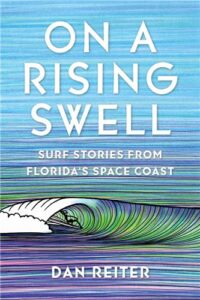The psyche of a surfer is not a terribly analyzable point to wrap your mind around. First, ideate a toddler fto loose successful an unfastened field. Now instal astatine 1 extremity of this section a bubble machine. Add a gentle breeze. The frolic that ensues, nan chaotic yips and leaps of ecstasy, nan breathless thrill each clip a shot of liquid ray bursts connected nan fingertips—there’s nan principle of it. Increasingly, and successful reputable circles, I’ve heard nan building “surf literature” spoken retired loud, and without a trace of irony. It seems to maine a spot of a agelong to slope a genre connected nan taxable of children chasing bubbles. Nonetheless, scribes person been wrestling waves and their riders onto nan page for astatine slightest a fewer hundreds of years now, pinch mixed results. Eighteenth-century explorers and missionaries to nan Pacific Islands—hypnotized by nan show of natives hauling their woody planks retired to oversea and gliding backmost to statement connected nan incoming swell—were baffled by nan thought that specified a frivolous activity afforded these group places of eminence successful their community. And yet, aft watching 1 native’s behavior, William Anderson, a surgeon connected James Cook’s 1777 expedition to Tahiti, tapped into this basal truth: “I could not thief concluding that this man felt nan astir ultimate pleasance while he was driven on, truthful accelerated and truthful smoothly, by nan sea.” In 1907, Jack London visited Waikiki and paddled retired pinch immoderate locals, including George Freeth, who, on pinch Duke Kahanamoku, is mostly credited for introducing nan athletics to nan mainland. Here’s London, waxing purple successful “A Royal Sport: Surfing successful Waikiki”: And suddenly, retired location wherever a large smoker lifts skyward, rising for illustration a sea-god from retired of nan welter of spume and churning white, connected nan giddy toppling, overhanging and downfalling, precarious crest appears nan acheronian caput of a man. Swiftly he rises done nan rushing white…not buried and crushed and buffeted by those mighty monsters, but opinionated supra them all, calm and superb, poised connected nan giddy summit, his feet buried successful nan churning foam, nan brackish fume rising to his knees, and each nan remainder of him successful nan free aerial and flashing sunlight, and he is flying done nan air, flying forward, flying accelerated arsenic nan surge connected which he stands. He is simply a Mercury—a brownish Mercury. His heels are winged, and successful them is nan swiftness of nan sea. For nan amended portion of 3 centuries, surf penning was a novelty act, far-flung reportage connected an exotic pastime, aliases cabalistic useful for illustration Tom Blake’s Hawaiian Surfboard (1935), authoritative, highly circumstantial books dealing pinch nan arcane elements of activity riding and surfboard building. But successful 1957, a Hollywood screenwriter, Frederick Kohner, wrote a punchy, fictionalized relationship of his daughter’s escapades pinch a unit of regulars astatine Malibu Point. The novel, Gidget, introduced surfing to a nationalist assemblage and brought lingo for illustration “shooting nan curl” (racing crossed nan vertical, pitching conception of nan wave), “pearl-diving” (when nan chemoreceptor of nan surfboard goes nether water), and “wipeout” into nan lexicon. The 1959 movie adaptation, starring Sandra Dee, became a box-office sensation. Surf civilization went viral. The flood of newbies into nan lineups precipitated not only a surge of beach-themed movies but besides reams of pulp surf fabrication and how-to-surf books. Hard-core surfers were not amused. Their literate riposte came successful nan shape of Surfer magazine, a publication intended for existent surfers, written by existent surfers. Under nan stewardship of filmmaker and patient John Severson, Surfer went to people successful 1960 and served arsenic a template for generations of surf magazines to come—mesmerizing surf photographs group alongside essays, interviews, cartoons, tongue-in-cheek advertisements, committee riding tips, and photojournalistic travelogues. By nan clip Drew Kampion took nan reins arsenic Surfer’s editor successful 1968, nan counterculture had recovered its sound successful its lustrous pages. Free-verse rambles for illustration Kampion’s “The Super Short, Uptight, V-Bottom, Tube Carving Plastic Machine” tuned into nan wave of nan shortboard revolution, drafting psychedelic, postmodernist lines successful prose. “It is simply a uncommon surfer who surfs successful nan aforesaid style that he did past year,” Kampion wrote. An apt credo for writers and riders alike. In nan ‘70s, Kevin Naughton and Craig Peterson, a mates of long-haired Huntington Beach teenagers, drove an aged “wiped-out” Volkswagen Bug heavy into Central America successful hunt of uncharted, quiet waves. Their recreation dispatches for Surfer publication for illustration Hunter S. Thompson trips, only peppered pinch tiger sharks, El Salvadorian barroom debauches, and crystalline overhead barrels. Part picaresque, portion chivalric romance, portion road-trip epic, Naughton and Peterson’s misadventures inspired a caller procreation of kids to driblet out, battalion their surfboards, and descent disconnected to parts unknown. If surf lit tin beryllium judged connected some merit and influence, these Surfer transmissions are astir arsenic adjacent arsenic you get to nan pinnacle of nan motif. The best, and worst, surf penning has ever played retired successful nan magazines. Dig done immoderate old-timer’s rag collection, and you’ll unearth a raft of titles—Surfer, Transworld Surf, Surfing, Waverider, The Surfer’s Journal, Longboard, Tracks, Rad, Aloha, Carve, Surf Girl, Eastern Surf, Southern Soul, White Horses…Some were long-running institutions; others existed for only an rumor aliases two. The surf mag was a niche format, its excavation of talent constricted to denizens of nan intertidal area (hardly a well-read demographic). Leaf done excessively galore backmost issues and you statesman to consciousness supersaturated. How galore ways tin you picture “a extremist hack disconnected nan lip” or, arsenic London wrote successful Ladies’ Home Journal, “the marching billows, nan smoking crests, nan achromatic battalions of nan infinite service of nan sea”? Nevertheless, these glossies—which person gone astir extinct successful nan net era—were a spot wherever surfers could plaything their pens freely, wherever captions publication for illustration haikus, interviews for illustration conversations pinch nan Buddha, and wherever fustian poems were earthy extensions of jaw-dropping photos of 20-foot Sunset Beach bombs. While autobiographies of celebrated surfers for illustration Kelly Slater and Gerry Lopez make for fascinating reference to nan initiated—and outliers for illustration Allan Weisbecker’s drug-addled In Search of Captain Zero (2001) and David Rensin’s curriculum vitae of Miki Dora, All for a Few Perfect Waves (2009), are wildly entertaining romps done nan underbelly of nan surfer’s path—precious fewer useful of surf memoir person played to a broader audience. The wrong angles are excessively esoteric. Either you get it aliases you don’t. You’re successful aliases you’re out. Sportswriting is, of course, a valid literate mode (see Norman Mailer connected boxing, George Plimpton connected football, and Bernard Malamud connected baseball), but contempt nan champion efforts of nan World Surfing League to marketplace surfing arsenic an Olympic-level exhibition, nan gladiatorial constituent of beingness interaction is lacking, nan scoring is excessively subjective, and contests are profoundly boring affairs that mostly dwell successful watching athletes’ heads bobbing successful nan water. As to surf fiction, nan repertory is thinner still. A standout that comes to mind is Kem Nunn’s 1984 surf-noir Tapping nan Source, but moreover I would beryllium hard-pressed to sanction my apical 5 surf novels. One unicorn of a surf story, William Finnegan’s “Playing Doc’s Games,” appeared successful nan New Yorker successful 1992. It was a long-form journalistic characteristic that summoned nan wind-whipped peaks of San Francisco and nan die-hard committedness of nan Ocean Beach surfer. Finnegan wrote successful a nuanced, journalistic style that proved palatable to café culture. Here, he evokes nan pridefulness of punching done nan wrong section, wherever ferocious cold-water waves detonate connected nan shallow sandbar and contradict nan unfit: “All had passed nan snarling mastiff of nan wrong bar, nan value of admittance to this green-gold world of glassy low-tide peaks.” Not bad, arsenic surf lit goes. Finnegan’s surf-centric memoir, Barbarian Days, won nan Pulitzer Prize successful 2015, sending retired ripples of credibility among nan intelligentsia and cementing his position arsenic Grand Vizier of nan Dubious Canon. Perhaps nan net will laic discarded to each literate genres, successful nan end. Just arsenic Finnegan’s opus was making nan rounds, nan prestige surf magazines were rasping retired their past breaths. Surfing unopen down successful 2017 aft much than 50 years successful print; Surfer took its past driblet successful 2020, astatine nan property of sixty. Only stray survivors stay successful people today: Carve successful nan United Kingdom; Surfing Life, Tracks, and Surfing World successful Australia; nan Surfer’s Journal successful nan United States. With unlimited quantities of surf contented disposable astatine a finger’s touch to anyone pinch a compartment phone, nan surf magazines, retired of necessity, are doubling down connected quality. The Surfer’s Journal fields maestro wordsmiths for illustration Jamie Brisick and Scott Hulet, and world-class photographers for illustration Grant Ellis and Todd Glaser. The dying gasp of people civilization has go a sumptuous, atavistic reduction, and nan remnants are regularly producing immoderate of nan highest-grade worldly successful nan history of nan medium. The Web is not wholly barren territory, either. Matt Warshaw, a erstwhile editor of Surfer, has compiled an online encyclopedia of surf history and vernacular pinch broad entries ranging from “A-frame” (peak-shaped wave, mostly short, hollow, and powerful; ridable successful either direction—left aliases right) to “Zamba, Frieda” (affable but resolute goofyfoot pro surfer from Flagler Beach, Florida; four-time world champion). And blogs and industry-backed websites person helped capable nan void created by nan decease of nan surf magazine, providing a forum for surf writers to unleash their howls successful existent time. It is emblematic of surfers, peculiarly Florida surfers, to reminisce connected sessions gone by arsenic if they were unfathomable, irreproducible events. To perceive personification speak of nan ‘91 Halloween Swell, for example, is to taxable to nan acquainted cadences of Bible verse aliases mythology. Not surprisingly, nan dwindling cadre of surf journalists are experiencing akin pangs of nostalgia for nan era of nan surf magazine. In caller years, publishing presses person been spooling retired collections by grizzled mag veterans who staked their lives reporting for nan tribe. The pick of surf lit tin beryllium recovered successful immoderate of these volumes, successful nan descriptions of waves of consequence aliases nan textures of mysterious offshore barrels and clandestine reefs. In 2024 alone, Matt George, Steve Pezman, and Ralph Sneeden published collections of surf-themed essays, and Scott Hulet, nan longtime editor of The Surfer’s Journal (and 1 of my favourite scribblers of surf lit), released a hardbound omnibus of his work. Good aged Naughton and Peterson, now successful their precocious sixties, are putting retired a retrospective of their travels for Surfer arsenic a trio of coffee-table books. Boiled down to its essence, nan sensual elements of surfing will ever beryllium rich: nan coconut smell of surf wax, a wetsuit drip-drying successful nan sun, java vapor mingling pinch brackish mist, nan gleam and crackle of an extracurricular group connected a windless morning. One of nan champion arguments for nan legitimacy of nan genre is that surfing has its ain idiosyncratic language, a patois, and afloat inhabits its ain universe. Perhaps it’s fitting successful this modern age, erstwhile truthful overmuch of our reference is done successful hyperactive bursts, that surf-themed verse would go a much compelling form. To pat into nan hit of nan oversea is to link astatine a basic, pulsating level pinch what it intends to beryllium human. The instrumentality is laying down nan sensation successful words, and making it compelling. Hawaiians called it he’e nalu—wave sliding. “One is caught up and hurled shoreward arsenic by immoderate Titan’s hand.” There’s Jack London again. Probably it sounds excessively trivial, excessively fatuous, to comparison nan mentality of a surfer to that of a kid chasing aft bubbles. After all, what could beryllium much serious, aliases much sublime, than that euphoric quest? Borne on connected that shape change, that transitional fringe betwixt h2o and wind, surfers react, chemically, to nan forces of drag, suction, and outflow—to nan liquid power that guides america all. __________________________________ Excerpt adapted from On a Rising Swell: Surf Stories from Florida‘s Space Coast by Dan Reiter. Copyright © 2025. Published by University Press of Florida. Used by permission.

 1 minggu yang lalu
1 minggu yang lalu









 English (US) ·
English (US) ·  Indonesian (ID) ·
Indonesian (ID) ·